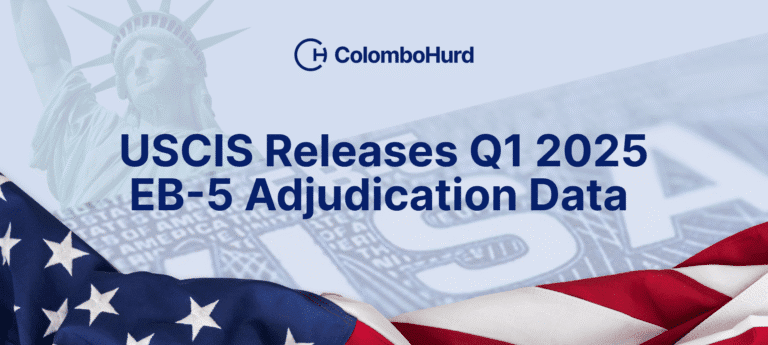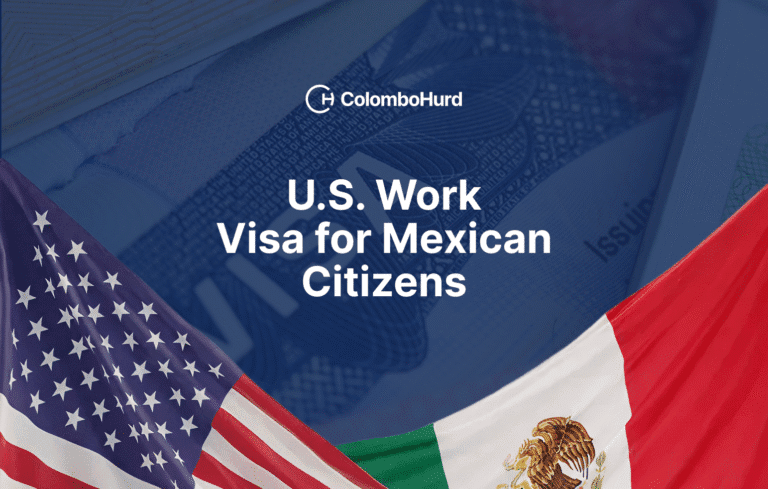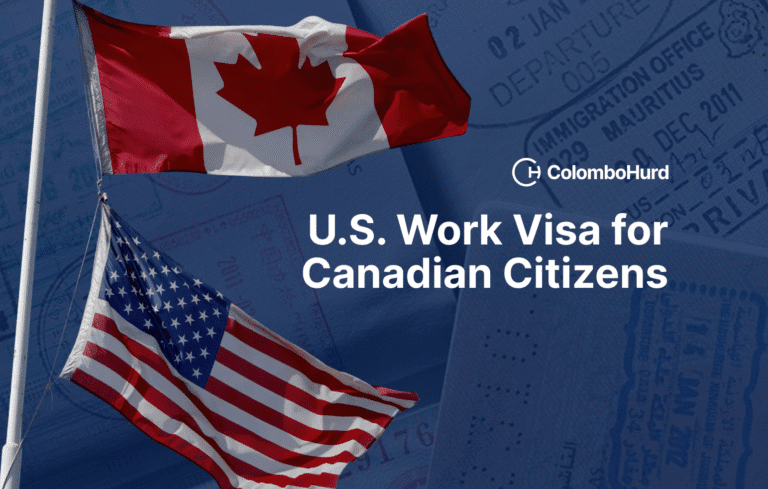Last week, USCIS released its quarterly data on EB-5 Immigrant Investor petition adjudications for the first quarter of fiscal year 2025 (covering October 1 through December 31, 2024). This data release provides critical insights into the program’s current state and offers valuable information for investors, regional centers, and industry stakeholders.
In this analysis, we’ll examine the key findings and their implications, with expert insights from Dallan Bunce, experienced EB-5 immigration attorney at Colombo & Hurd.
Overview of the Q1 FY2025 Data Release
The Q1 FY2025 data release shows that USCIS’s Immigrant Investor Program Office (IPO) processed 202 I-526E petitions during this quarter, with approximately 7,000 cases remaining pending. This represents a quarterly completion rate of approximately 2.9% of the pending inventory.
The FY2025 Q1 report includes, for the first time, median processing times for post-Reform and Integrity Act (RIA) I-526 and I-526E petitions. As explained in the report’s footnote, “Processing times are defined as the number of months it took for an application, petition, or request to be processed from receipt to completion in a given time period. The number of months presented is the median which is the time it took to complete 50% of all the cases processed in the quarter.”
This methodology means the processing time reflects only completed cases, not the projected wait time for currently pending cases. With only 202 completions representing a small fraction of the overall pending inventory, the statistical significance of these median processing times remains uncertain.
Colombo & Hurd immigration attorney Dallan Bunce offers context on factors that can influence USCIS processing capacity:
“While USCIS is funded largely by application and petition fees, they, like other administrative agencies, also feel the squeeze when a new administration starts to slash budgets. With budgetary constraints come staffing issues, with staffing issues come fewer people to review petitions, and with fewer people to review petitions, wait times increase. It is for this reason that it might be wise to file a petition sooner than later to preserve your spot in line.”
Processing Times: I-526E Petitions vs. Legacy Petitions
Before the RIA, all EB-5 petitions were filed using Form I-526—these are now called “Legacy Form I-526” petitions. After the RIA, USCIS created two distinct forms: Form I-526E for investments affiliated with Regional Centers and Form I-526 for standalone investors (typically Direct projects).
The Q1 data shows a notable disparity between processing times for the new I-526E petitions and legacy I-526 petitions. As Mr. Bunce says:
“In essence, it’s showing us that petitions filed by investors after the RIA are having their petitions evaluated before legacy investors. A ‘legacy’ investor is an investor that filed their petition before the RIA. This is in-line with USCIS’ revised approach to adjudicating I-526 Petitions. Now, USCIS prioritizes adjudicating petitions for whom visas might be immediately (or soon) available, instead of adjudicating them on a first-in, first out basis.”
The Q1 data provides several key insights into the current EB-5 landscape. During this quarter, USCIS received 63 standalone petitions and 1,359 Regional Center petitions. This may suggest that Regional Center investments are perceived in the marketplace as more attractive investments than standalone investments.
Interestingly, the median processing time for standalone investments is actually 2 months shorter than for Regional Center investments (10.1 months vs. 12 months), a somewhat perplexing statistic that might be influenced by outliers or other factors not evident in the data. However, the most striking figure remains the 70.9-month median processing time for investors who filed before the RIA.
With only 202 I-526E adjudications completed out of nearly 7,000 pending cases, the sustainability of these processing times remains uncertain. The report doesn’t clarify USCIS’s selection criteria for which petitions are processed first, resource allocation between different petition types, how staffing levels affect overall productivity, or how complexity varied across the adjudicated cases.
EB-5 Visa Demand Exceeds Availability
It’s important to note several limitations when interpreting this quarterly processing data:
- Small Sample Size: With only 202 adjudicated I-526E petitions, statistical conclusions about processing times and approval rates should be made only with caution.
- Uneven Distribution: The adjudications may not be evenly distributed across project types, investor nationalities, or investment amounts, potentially skewing the averages.
- Timing Factors: External factors such as staffing changes at USCIS, policy adjustments, or temporary processing initiatives may have influenced this quarter’s numbers.
The data also doesn’t reveal certain important details, such as the breakdown of cases by regional center versus direct investment, or the distribution of petitions across different countries of origin, which would provide more context for understanding the program’s current dynamics.
However, recent data from American Immigrant Investor Alliance (AIIA)’s Freedom of Information Act (FOIA) requests for information from USCIS provides additional context for understanding the EB-5 visa situation.
According to these FOIA results, by the end of January 2025, 5,191 investors had filed petitions in the high unemployment area (HUA) set-aside category, and 4,329 investors had filed in the rural category.
This demand substantially exceeds the statutory annual visa availability of 1,000 HUA visas and 2,000 rural visas. With petition filings continuing to increase while processing remains slow, the gap between available visas and qualified applicants continues to widen.
Strategic Considerations for Investors
Considering these findings, EB-5 investors face important strategic decisions.
For prospective investors considering the EB-5 program, the data suggests that new I-526E filers may experience faster processing times compared to pre-RIA investors, despite the growing backlog. The disparity in processing times (12 months vs. 70 months) suggests that post-RIA petitions may be prioritized. However, this advantage should be considered in the context of the overall slowdown in processing volume.
For investors with children approaching age 21, the Child Status Protection Act (CSPA) offers a critical opportunity. Under CSPA provisions, the time that an I-526E petition remains pending can effectively “lock in” a child’s age, potentially preserving their eligibility as derivatives even if processing delays extend beyond their 21st birthday. This protection becomes increasingly valuable given the current processing timelines.
Regional centers and project developers face their own strategic considerations. Interestingly, rural projects appear to be attracting higher demand than initially anticipated. This trend suggests that the rural targeted employment area (TEA) incentives created by the RIA are having their intended effect, despite concerns about risk profiles of projects in less-developed areas.
The data also underscores the need for comprehensive, well-prepared petitions that minimize the risk of RFEs or denials. With processing resources already strained, ensuring applications are strong from the outset becomes even more critical.
Conclusion and Future Outlook
The Q1 FY2025 data provides a statistical snapshot of the EB-5 program’s current state. The numbers show a processing volume of 202 I-526E petitions, with approximately 7,000 cases remaining pending, and a strong disparity between the median processing times for new versus legacy petitions.
The American Immigrant Investor Alliance FOIA data adds important context regarding the demand for set-aside visas, but still leaves open questions about how this demand will be managed against limited visa availability.
While the 12-month median processing time for I-526E petitions in Q1 FY2025 is promising, the reality of processing capacity suggests a more complex and potentially challenging future for the program.
As with any complex immigration program, the numbers alone tell only part of the story. We strongly encourage potential and current EB-5 investors to speak with an immigration attorney if you have any concerns or face complex situations related to your petition. Our team at Colombo & Hurd is happy to help you stay informed and up-to-date with the latest immigration policies and procedures to avoid surprises and navigate the evolving EB-5 landscape effectively.





